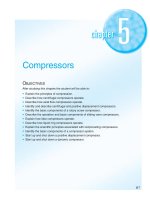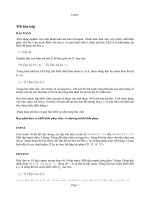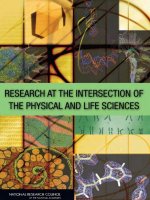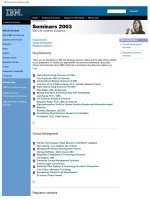5 6 changing world (life science)
Bạn đang xem bản rút gọn của tài liệu. Xem và tải ngay bản đầy đủ của tài liệu tại đây (3.3 MB, 10 trang )
Genre
Nonfiction
Comprehension Skill
Cause and Effect
Text Features
•
•
•
•
Labels
Captions
Sidebars
Glossary
Science Content
Changing
Ecosystems
Scott Foresman Science 5.6
ISBN 0-328-13933-5
ì<(sk$m)=bdjd a< +^-Ä-U-Ä-U
Vocabulary
Extended Vocabulary
behavioral adaptation
extinct
inherit
mutation
pesticide
structural adaptation
acid rain
bedrock
deforestation
drought
endangered
fossil fuels
herbivore
thermal pollution
Picture Credits
Every effort has been made to secure permission and provide appropriate credit for photographic material.
The publisher deeply regrets any omission and pledges to correct errors called to its attention in subsequent editions.
Photo locators denoted as follows: Top (T), Center (C), Bottom (B), Left (L), Right (R), Background (Bkgd).
8 (TR) Andre Maslennikov/Peter Arnold, Inc.; 14 Andrew Brown; Ecoscene/Corbis.
Scott Foresman/Dorling Kindersley would also like to thank: 1 NASA/DK Images.
Unless otherwise acknowledged, all photographs are the copyright © of Dorling Kindersley, a division of Pearson.
ISBN: 0-328-13933-5
Copyright © Pearson Education, Inc. All Rights Reserved. Printed in the United States of America.
This publication is protected by Copyright, and permission should be obtained from the publisher prior to any
prohibited reproduction, storage in a retrieval system, or transmission in any form by any means, electronic,
mechanical, photocopying, recording, or likewise. For information regarding permission(s), write to
Permissions Department, Scott Foresman, 1900 East Lake Avenue, Glenview, Illinois 60025.
3 4 5 6 7 8 9 10 V010 13 12 11 10 09 08 07 06 05
What did you learn?
1. Why are animals becoming endangered?
2. How do farms affect ecosystems?
3. What are some ways waterways can become
polluted?
4.
Purple loosestrife is a
flowered plant brought to the United States
from Europe inby
theNatalie
1800s. ItRompella
does not have
any natural enemies in its new habitat and
has spread throughout forty-nine of the fifty
states. What consequences do you think this
has on its new ecosystem? Write to explain
your answer. Use information from this book
to support your ideas.
5.
Cause and Effect Name a cause and
effect of habitat loss.
What You Already Know
There are many factors that affect ecosystems. Animals
can change ecosystems in both positive and negative ways.
Earthworms help by adding oxygen and nutrients to the soil.
Insects, such as swarms of locusts, can cause major damage
to crops. People change ecosystems too. Over time, people
have moved plants and animals from their native ecosystems
to new ones. Sometimes this changes the food chain of
the ecosystem or takes away space from the native plants
and animals.
The plants and animals in ecosystems can also adapt
over time. Genes are passed down from each parent to their
offspring and control such things as eye color and weight.
Offspring will often resemble one or both of their parents.
The ecosystem can even have an effect on what an organism
looks like. The color of flamingos, for instance, is a result
of their diet. The kind of soil some flowers grow in can
affect their color.
Earthworms add nutrients
and oxygen to soil.
2
A mutation sometimes occurs in the genes that are passed
down. This change may end up helping the organism, for
example, by making it blend in better with its surroundings.
Or it may harm the organism by making it more prone to
disease. Or the change may be neutral. If this mutation helps
the organism adapt, it has a better chance for survival.
Some adaptations are structural adaptations. They are a
change to a body part that helps the organism survive better.
Behavioral adaptations, also called instincts, are changes
in behavior that help creatures survive. Offspring inherit
these adaptations from their parents.
If a species does not adapt to changes in its ecosystem,
it may become extinct. When this happens the species will
never return.
Can you guess what causes ecosystems to change more
quickly than anything else? The answer may surprise you:
it’s humans. Keep reading to learn what kind of impact
people are having on
their environment.
A tiger’s stripes are
an adaptation that
helps it blend into
its surroundings.
3
Acid rain affects trees by damaging their
leaves and polluting the soil that gives
them nutrients.
Introduction
Our world is constantly changing. One change to an
ecosystem can have many consequences for its inhabitants.
Some changes have natural causes, such as hurricanes and
tornadoes. People, however, can also change ecosystems. Our
actions can affect the habitats of plants and animals. Over
time our technology has caused drastic change to our world.
In Europe during the 1760s, people began using machines
to do work. Tasks that were once done by humans or with
the help of animals were suddenly being done in less time
with the help of machines. Coal was the main power source.
But it made thick, black smoke, which clouded the air.
Factories produced wastes that polluted streams, rivers,
and lakes.
Advances in technology soon spread across the world.
Better medical care allowed populations to grow. More
farms were needed to feed the increasing numbers of people.
Trees were cut down to make room for corn and rice fields
as farms grew and grew. Animals that once relied on the
forests lost their homes.
People still change ecosystems. For example, power
stations, automobiles, and pesticides used by people cause
pollution. Populations are growing faster than ever, requiring
more land to be cleared for farming. Read on to learn more
about how people’s actions affect ecosystems and the plants
and animals that live in them.
4
Pesticides and fertilizers from farms
can end up in nearby waterways,
affecting the aquatic life.
Power stations burn fossil
fuels that pollute the air.
Fumes from industry and
automobile exhaust are
higher in cities than
rural areas.
Ships that carry oil
sometimes leak or spill,
causing the oil to end
up in waterways.
5
Changing Habitats
Why doesn’t a polar bear get cold in the Arctic? How
does a cactus survive in the desert without much water?
Plants and animals have adapted to survive in a wide range
of habitats. Many animals in the Arctic, for instance, have
layers of blubber and thick fur to help them stay warm in
the extreme cold. Desert plants, such as cactuses, are able to
live without much water. They also absorb rainwater quickly
and are able to store it for droughts, which are times when
less water than normal is available.
Unfortunately, sometimes habitats are changed so much
that it is hard for plants and animals to adapt. Many times,
humans cause these changes.
Deforestation has caused
many animals and plants
to lose their homes.
6
Around the world, large numbers
of trees are cut down by humans.
This is called deforestation.
Sometimes the wood is needed
to make products such as
lumber and paper. Other
times, trees are cut down to
clear the land for farming or
building. Many animals use the
trees for homes or hide in them
to escape predators.
A similar problem is happening
in the rainforests, where there is a
wide variety of plants and animals.
Animals rely on the plants for food
and shelter. Humans also rely on
many of the plants for medicines,
food, and other products.
Even in the ocean, habitats
are being destroyed. Coral
reefs are a special saltwater
habitat created by coral, an
unusual animal related to the
jellyfish. Coral reefs are home to
many different ocean plants and
animals. Pollution and higher
sea temperatures are hurting
coral populations. This affects not
only the coral, but all of the other
animals and the plants that live there.
The saguaro cactus
adapts well to its dry
desert habitat.
Coral reefs face threats
from pollution and
warmer temperatures.
7
Effects of Industry
Since industry first began,
pollution has been a problem.
Factories and power stations need
fuel in order to produce energy.
Many run on fossil fuels, such
as coal, oil, or natural gas. When
burned, these fuels can cause
air pollution. This can result
in acid rain, which contaminates
water. Acid rain can cause damage
to the outsides of buildings and be
unhealthy for animals to drink. Acid
rain seeps down into the soil too.
This can cause the acidity of the soil
to change. Then aluminum may be
released into lakes and rivers.
Aluminum is very dangerous
for fish and other marine
animals. It can also hurt the
predators of these animals.
8
Acid rain can make
trees unhealthy.
Some factories and power
stations also produce unwanted
heat. They reduce this heat
with cold water and then pump
the water into rivers. This can
cause serious problems for the
environment. The river water
becomes heated, which reduces
the amount of oxygen it can
hold. This is called thermal
pollution. Marine species such
as fish need a certain amount of
oxygen in the water. Without it
they can die. Animals that eat
fish are, in turn, affected if
there is less food.
Power stations can
cause acid rain or
thermal pollution.
Adaptation
Most peppered moths
used to be gray, to
blend in with the
light-colored trees
where they lived. Then
humans polluted the
environment, turning
the trees black. Black
moths became more
successful, because
they blended in better
with the black trees.
9
Effects of Farming
How can farming affect ecosystems? Herding of animals
and plowing can result in soil erosion. Soil erodes when its
protective, top layer, called topsoil, is worn away. Without
topsoil, plants can’t grow. With no plants or topsoil, any
fertilizer that farmers use gets washed into nearby lakes and
rivers by rain. The fertilizers cause large amounts of algae
to grow in the water. The algae use up the oxygen that other
living things in the water need to survive.
Normally, plants help to keep
the nutrients in the soil.
Topsoil is a protective top
layer of soil where plants
grow. It is rich in nutrients
and helpful organisms, such
as earthworms.
Clearing land for farming
can also destroy habitats. Many
times, trees and other plants
are removed to make way for
farmland. Both may have been
used by animals for food or
shelter. If herbivores do not have
plants to eat and cannot survive,
neither can the animals that eat
the herbivores. Even butterflies
rely on plants for survival. If the
plants are taken away, they are
not able to lay eggs.
Prairie dogs can lose their
homes because of farming.
Plows are used on
farms to break up the
soil. Overplowing,
however, can cause
the soil to erode.
Subsoil is not as rich in nutrients
as the topsoil above it. It
contains more clay and salts.
Bedrock particles make the
layer below the subsoil rocky.
The bedrock layer is made of
hard stone.
10
11
Endangered!
What do the giant panda, the whooping crane, and the
white-whiskered spider monkey all have in common? All
are endangered animals that have lost their habitats due to
farming or deforestation. If an animal’s habitat is destroyed,
the animal loses its home and food source. The tapir is an
endangered animal found in Asia. It has lost its habitat
because of farming, logging, and mining. The golden lion
tamarin, a kind of monkey, has had its forests cut down for
lumber and charcoal, and to make room for plantations,
ranches, and farms. Another reason tamarins are endangered
is that they are captured for zoos and pet stores.
New Zealand was home
to the tuatara, a reptile, for
millions of years. Humans,
however, introduced rats, wild
cats, and pigs to the islands.
This had disturbing effects on
the tuatara. Its eggs and young
were eaten and there was more
competition for food. The
tuatara is now only found on
thirty of New Zealand’s small,
offshore islands.
The Dodo
Humans discovered the
dodo bird about four
hundred years ago and
drove it to extinction
in under one hundred
years. This was due
to deforestation,
as well as the
introduction of cats,
rats, and pigs to the
dodo’s island habitat.
golden lion tamarin
tapir
tuatara
12
13
Solutions
Humans are learning the effects of not taking good care
of our planet. Over the years, organizations have worked to
help educate people and protect ecosystems.
The World Wildlife Fund (WWF) is an organization
that helps to protect endangered animals from becoming
extinct and works to preserve their habitats. The WWF
has been working for this cause for more than forty years.
Making a Return
Many animal populations that
were once close to extinction
are now growing again. Through
protection and controlled
breeding, the Arabian oryx has
been reintroduced to its original
habitat in Saudi Arabia. The
European bison had gotten to
the point of extinction in the wild
due to deforestation. With the
help of scientists, the European
bison has been brought back
to the woods and grasslands
of Western Europe.
14
The Environmental Protection Agency (EPA) works
to make sure that humans are creating a healthy, safe
environment, not only for plants and animals, but also for
themselves. The EPA makes sure that environmental laws are
in place and that they are followed. Some laws keep factories
from dumping wastes into rivers, lakes, or oceans.
What can you do to make a difference? Right now, what
you buy can help the environment. Try to buy things that
don’t have much extra packaging, which becomes waste.
When you grow up, you can vote for leaders who will pass
laws to protect the environment.
Thanks to all of the efforts to help our planet, many
plants and animals are being taken off the endangered list.
Streams are becoming clean again. Trees are being replaced
and animals are returning home.
Arabian oryx
Plastic tubing shelters
young trees.
bison
15
Vocabulary
Glossary
Extended Vocabulary
behavioral adaptation
acid rain
extinct
bedrock
acid
rain
precipitation
polluted with acids
inherit
deforestation
mutation
drought
bedrock
the rocky endangered
layer under the soil
pesticide
structural adaptation
fossil fuels
deforestation
the cuttingherbivore
down or clearing away of
trees, for lumber
to make room
thermalorpollution
for factories, farms, and homes
drought
a period of low rainfall
endangered
in danger of becoming extinct
fossil fuels
coal, oil, and natural gas formed
deep in the ground from ancient
plants and animals
herbivore
an animal that eats plants
Picture Credits
Every effort has been made to secure permission and provide appropriate credit for photographic material.
The publisher deeply regrets any omission and pledges to correct errors called to its attention in subsequent editions.
thermal pollution
the overheating of water, which
affects marine life
Photo locators denoted as follows: Top (T), Center (C), Bottom (B), Left (L), Right (R), Background (Bkgd).
8 (TR) Andre Maslennikov/Peter Arnold, Inc.; 14 Andrew Brown; Ecoscene/Corbis.
Scott Foresman/Dorling Kindersley would also like to thank: 1 NASA/DK Images.
Unless otherwise acknowledged, all photographs are the copyright © of Dorling Kindersley, a division of Pearson.
ISBN: 0-328-13933-5
Copyright © Pearson Education, Inc. All Rights Reserved. Printed in the United States of America.
This publication is protected by Copyright, and permission should be obtained from the publisher prior to any
prohibited reproduction, storage in a retrieval system, or transmission in any form by any means, electronic,
mechanical, photocopying, recording, or likewise. For information regarding permission(s), write to
Permissions Department, Scott Foresman, 1900 East Lake Avenue, Glenview, Illinois 60025.
3 4 5 6 7 8 9 10 V010 13 12 11 10 09 08 07 06 05
16
What did you learn?
1. Why are animals becoming endangered?
2. How do farms affect ecosystems?
3. What are some ways waterways can become
polluted?
4.
Purple loosestrife is a
flowered plant brought to the United States
from Europe in the 1800s. It does not have
any natural enemies in its new habitat and
has spread throughout forty-nine of the fifty
states. What consequences do you think this
has on its new ecosystem? Write to explain
your answer. Use information from this book
to support your ideas.
5.
Cause and Effect Name a cause and
effect of habitat loss.









